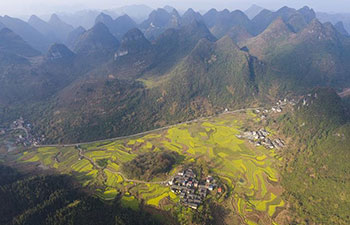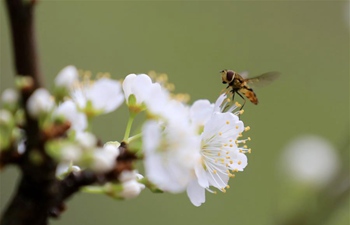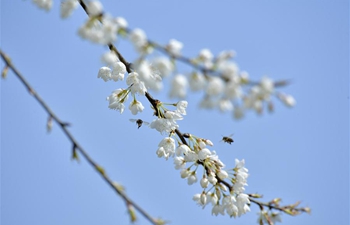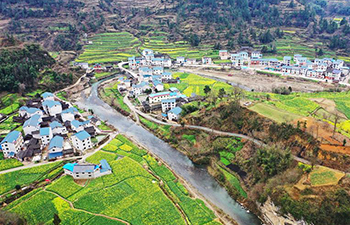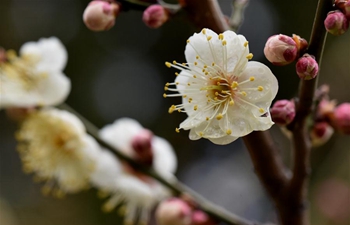BEIJING, March 12 (Xinhua) -- With building a "Beautiful China" high on the national agenda, China has been tapping into its creativity to make a greener country.
From integrating green finance with the Internet, to encouraging a "forest economy" in the countryside, and planting specific kinds of trees in the mining areas, the country is exploring ways to combine afforestation with its socio-economic development.
Tuesday coincides with China's annual National Tree-planting Day, created in 1979. The country's forest coverage rate has increased nearly 10 percentage points during the past four decades.
With a plan to increase its forest coverage rate to 26 percent by 2035, more is expected from China's afforestation effort.
GROW A TREE ONLINE
As long as it is possible, Wang Qi commutes on foot instead of relying on vehicles. During the past three years, he planted two virtual trees with the "energy points" he won by walking.
"Now I am on my way to plant my third tree. It gives me a sense of fulfillment," said Wang, who currently works as a volunteer in southwest China's Tibet Autonomous Region.
Wang is among the hundreds of millions of users of Ant Forest, a scheme launched in August 2016 on China's leading online payment platform Alipay.
Ant Forest encourages users to engage in low-carbon activities such as choosing electronic receipts over paper, and walking to work instead of driving, according to Ant Financial, the Alibaba affiliate that runs Alipay.
Such behavior is translated into virtual "green energy points" that can be used to grow virtual trees on the Alipay app, which are converted into real trees planted by Ant Financial and its philanthropic partners.
By the end of 2018, some 400 million people have joined Ant Forest, planting over 55.5 million trees in places such as Gansu Province and Inner Mongolia Autonomous Region. These users had helped reduce 3 million tonnes of carbon emission in total, the company said.
PLANT TREES ON "POISONOUS" LAND
With the approaching of National Tree-Planting Day, Tong Fangping has been busy selecting saplings from the garden, which will be sent to highly-polluted mining areas.
Tong is the head of the forestry research institute of Hunan Academy of Forestry. During the past decade, he has led his team to select and breed tree species appropriate for the mining areas of Hunan Province.
"We found that the Broussonetia papyrifera, Ligustrum compactum and Catalpa bungei are most capable of absorbing pollutants such as lead, cadmium and arsenic," he said. "These three species can grow in extremely polluted places."
While trees such as beech, camphor and oak can be planted on land with high or medium levels of pollution, he added.
It is highly challenging to plant trees in mines. Tong said that some of the land there was barren without any soil. One has to dig into the slags and fill the ditches with soil before planting.
Under the joint effort of Tong's team, local authorities and residents, some mining areas have turned green over the past few years.
In the city of Lengshuijiang, one-third of the once-barren 6,666 hectares of the tin ore mines are now covered by trees. The content of heavy metal in the soil of the mines has dropped 20 percent from 2011.
In the city of Chenzhou, the once-heavily polluted Baoshan copper mine has been turned into a park. During the past nine years, over 3 million trees were planted there.
NOURISH TREES WITH CHICKEN EXCREMENT
In Luzhu village of Changting County, Fujian Province, 20,000 chickens are walking idly in the mountain forest.
The chicken feed on grass and sleep on the trees or in their houses built in the forest. And the chicken's excrement is an ideal manure for the trees, said Lan Xiu, the chicken keeper.
The county is famous for Hetian chicken, a breed known for its delicious meat. However, severe soil and water loss in the county has endangered the Hetian chicken industry during the past decades.
Responding to the government's call to afforest the mountains, Lan Xiu planted 5,000 seedlings on a piece of land in 2009 and started to raise chicken in the woods.
Due to a lack of planting experience, half of the trees died but Lan did not give up. The wood gradually expanded with all kinds of trees added to it, including bamboo, tea trees, mulberry and osmanthus.
The "green chicken" grown up in the forest is sought after in the market. Lan's chicken are sold to places including Beijing, Shanghai and the provincial capital of Fuzhou.
Lan said that the chicken farm made a net income of over 1 million yuan (148,927 U.S. dollars) last year. Many of her neighbors also joined the business.
In 2018, Lan received a 1 million yuan subsidy from the provincial agricultural department. The chicken houses in Lan's farm are now equipped with automatic feeding and cleaning machines.
Lan's chicken farm is just one example of the county's success story in forest economy.
By the end of last year, the county boasted more than 11,486 hectares of forest farms that keep all kinds of animals such as porcupines, frogs and goats. The forest coverage rate of the county has reached 79.8 percent.









